Palm trees are usually a breeze to take care of, growing quickly and rarely giving you any insect or disease headaches. Healthy palms are naturally resilient, but sometimes they can still fall victim to common problems.
Is your palm tree dying and you don’t know what to do? Here are some telltale signs that your palm might need some TLC: leaves that are spotted, discolored, or frizzled; new shoots that are looking a bit wonky; leaves that are drooping, turning yellow, brown, or even black; or an unpleasant odor coming from the trunk or the bud.
Keep in mind, that it’s normal for the older palm fronds to turn brown, dry out, and die since they are being replaced with the new growth. However, if you’re seeing a lot of brown or yellow leaves, that’s a different story.
Why Is My Palm Tree Dying?
Well, before you jump into rescue mode, you’ve got to play detective and figure out what’s causing the trouble.
It could be your day-to-day care routine, a lack of nutrients, the weather, a pesky disease, some unwanted insect guests, or even a previous injury. Most folks dive straight into saving the day without understanding the “why” part.
They start snipping away at the sad and sickly leaves, dump some fertilizer in the soil, and crank up the watering.
And if that doesn’t do the trick, they go all out and transplant the palm to a new spot with better soil. But here’s the thing: all these moves can actually stress out your palm even more and make it weaker.
So, here’s the game plan: first, take a good look at your everyday palm care routine, and then let’s talk about the next steps. In this post, I’ve got 30 of the most common palm problems and how to tackle them.
But remember, an established palm tree will face different issues than a newbie in the ground. So, keep that in mind as you dive into the palm-saving adventure.
Newly Planted Outdoor Palm Tree Exhibiting Brown, Yellow, or Drooping Leaves
It’s quite common for a newly planted palm to experience something known as “transplant shock.” This happens when its roots get shaken up and exposed to the elements, like air and sunlight. When you relocate a palm tree, it loses a good chunk of its roots, which can lead to some water loss in its leaves.
So, don’t fret if your freshly planted palm is rocking brown, yellow, or droopy leaves; it’s just part of the recovery process. It might also be adapting to new light levels, humidity, and temperatures. Here’s the plan:
- Keep that palm well-watered.
- Hold off on the fertilizers for now.
- Resist the urge to trim those ailing leaves until they’re completely dried out because palms recycle nutrients from the old leaves to fuel new growth.
- Check the drainage. If your palm’s leaves are drooping, it could be an indication of poor drainage. Take a closer look at your soil. Did you use a specific soil mix when you planted the palm? Ensuring proper drainage is crucial for the health of your palm tree.
- Check the depth. If after a few weeks, it’s still not doing well, it might have been planted too deep. If the root ball has dropped, you might have left air pockets in the soil when backfilling the hole. And now the palm is sitting too deep. You will need to re-plant it.
- If the tree was damaged during planting, spray it with Copper Fungicide to prevent fungi and bacteria from developing.
- If it’s still not bouncing back, inspect the leaves and the bud (the spot where new leaves sprout) for any signs of insects or diseases. I’ve got treatments for both down below.
Established Outdoor Palm Tree Exhibiting Yellow, Brown, or Drooping Leaves
When it comes to established palms, we can quickly rule out a bunch of issues. These hardy trees have been holding their own in the same spot for a while, so we can safely say it’s not about getting used to the light levels, drainage, soil quality, planting depth, sunburn, or wrong climate.
For an established palm to start looking different, it’s usually a more serious problem. The primary reasons often include:
- Insufficient watering: Take a peek at the soil moisture levels; maybe your palm is feeling a bit dry.
- Nutrient deficiency: The next common problem is a lack of nutrients. Have you been feeding your palm regularly? Check those nutrient levels to see if anything’s running low.
- Cold damage: Did the winter bring any freezing temperatures that might have caused damage?
- Insects or diseases: Normally, only stressed-out palms fall victim to bugs and diseases. Examine the leaves and the bud for any signs of unwelcome visitors like pests or fungi.
30 Reasons Your Palm Tree is Dying and How to Save It Fast
When pinpointing the problem, I suggest starting with a thorough evaluation of your everyday palm tree care routine. If that doesn’t resolve the issue, move on to the next topic, make the necessary adjustments, and observe how your plant responds.
1. Over-Watering
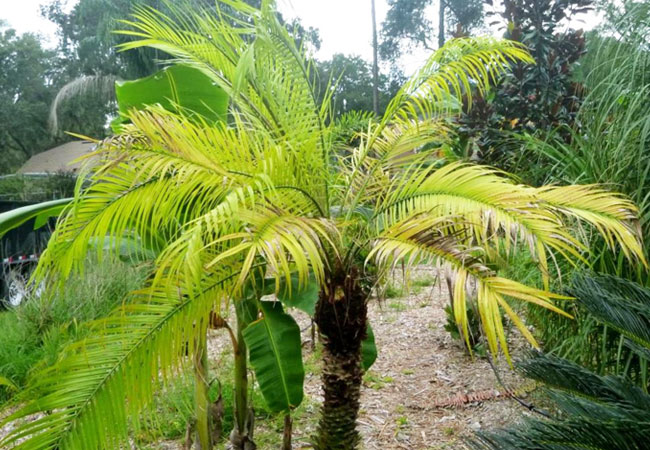
The first sign of over-watering is yellow or brown leaves that fall off before they have a chance to dry. It’s crucial to identify the type of palm you have, as different varieties have varying water requirements.
As a general rule, palms require more water during their growth season in the summer and less in the winter. They prefer soil that’s consistently moist but well-drained. To tackle this issue, consider adding 30% sand to the soil to improve drainage.
2. Not Enough Water
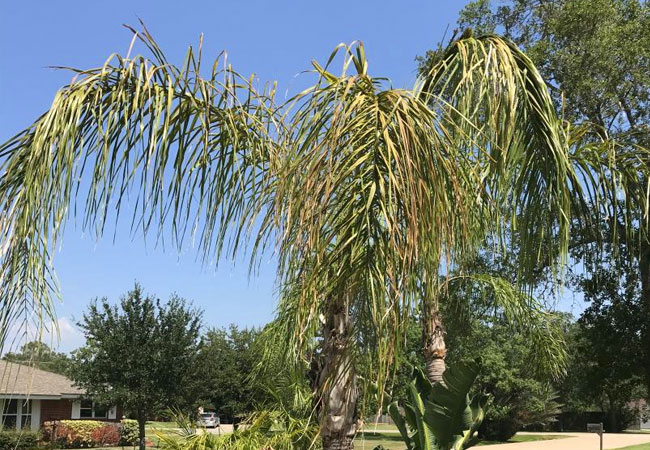
When your palm isn’t getting enough water, you’ll notice the tips of its leaves drying out and turning brown. To check the moisture level of the soil, inspect it the day after watering. You can gauge soil moisture by inserting your fingers about 3 inches into the soil.
Alternatively, you can use an electronic soil moisture meter, which I highly recommend—it provides accurate and easy-to-read results. If it indicates that the soil is too dry, increase the frequency of your watering.
During hot, dry seasons, employing the deep watering technique is most effective. Rather than dousing the palm with a lot of water all at once, gradually drip it over an extended period.
This allows the roots more time to absorb the moisture. This technique is especially crucial for newly planted palms that haven’t established a strong root system yet.
If possible, consider installing a sprinkler system and setting it on a schedule. This way, you won’t need to constantly monitor watering. For further insights and watering tips, check out my article on palm tree watering.
3. Planting Too Deep
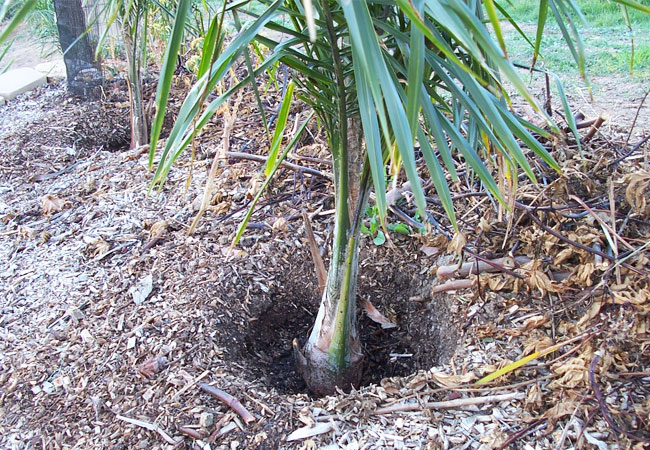
This issue mainly concerns newly planted palms. When you’re putting a palm in the ground, it’s crucial to ensure it’s at the same depth as it was grown before. Planting it too deep can lead to nutrient and water deprivation.
You’ll notice the top of the palm looking sparse and thin. If you realize you’ve planted it too deep, your best bet is to replant it. If that’s not an option, carefully remove some soil from the top. For detailed planting instructions, check out my article on palm tree planting.
4. Poor Soil
Again, this applies more to newly planted palms. If you’ve had this palm for a while, and it’s been thriving, then soil might not be the issue. Good soil should retain adequate moisture while providing excellent drainage.
Soil with poor drainage can harm the roots and lead to root rot. You might spot yellow or dark brown markings on the leaflets, and the new leaf spear may become discolored and wilted.
First, give it a spray with Copper Fungicide to stave off bacteria and fungi. Then, work on improving the plant’s drainage. To avoid this problem, I recommend enhancing drainage before planting the palm. Conduct a drainage test to assess your soil type.
If water doesn’t drain well, you can improve it by drilling holes in the ground, adding rocks to the bottom of the hole, mixing sand into the soil, or installing a drainage pipe to redirect excess water away from the tree.
Try to pair your palm with other plants that share similar water requirements. Also, avoid using soil mixed with fertilizer, as it could potentially harm the roots.
5. Not Enough Sunlight
When your palm craves more sunlight, its leaves will start turning brown. Established palms that have been growing in the shade for some time have already adapted and won’t demand additional light.
This concern is more relevant to newly planted palms. Check the palm’s specifications for its light requirements; you may need to consider replanting it to a sunnier spot.
6. Sunburn
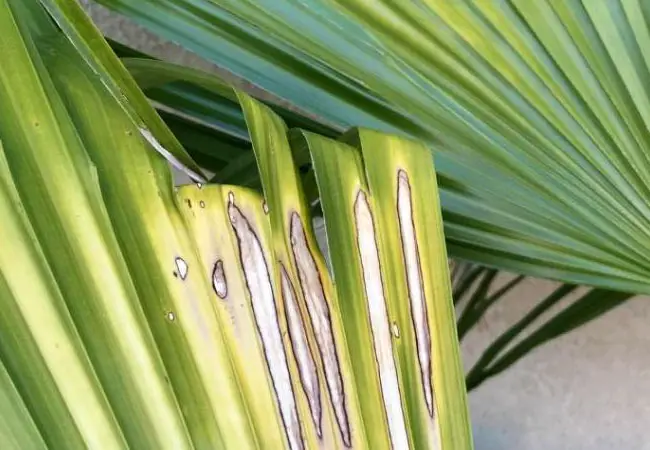
While some palms thrive in full sun, planting a young tree directly in the full sun can lead to sunburn. Signs of sunburn include palm leaves turning yellow and developing colorless areas.
To prevent sunburn, acclimatize the palm first. Here are a couple of methods to do so: If it’s a new palm still in a pot, place the pot in a shaded area initially and gradually increase the exposure to sunlight every week by moving it closer to a sunnier spot.
Another method is to plant the palm in full sun and use a plastic cover above it. You can use four sticks to hold the plastic in place. Each week, increase the light exposure by creating more holes in the plastic.
7. Nutrient Deficiency
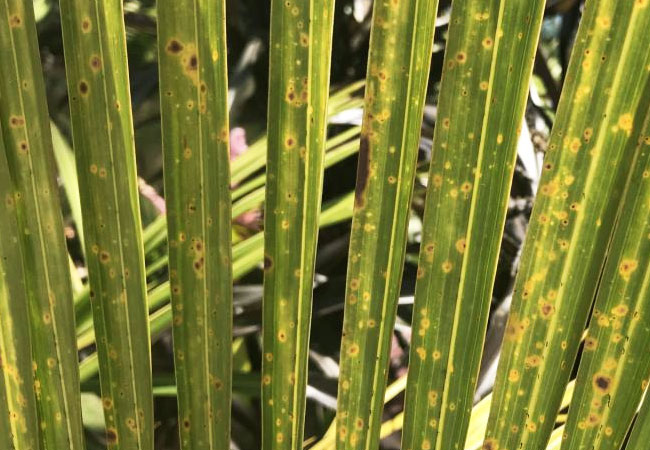
Providing your palm with all the necessary nutrients is crucial for healthy growth and disease resistance.
- If you notice small yellow, orange, or bronze spots covering nearly the entire blade of the palm leaves, it’s a sign of potassium deficiency. Use a slow-release potassium fertilizer and a magnesium fertilizer to maintain soil balance.
- Stunted and deformed leaves may indicate a calcium deficiency, which can be corrected with Calcium Nitrate.
- If your leaves have yellow bands running along the borders, it’s a sign of magnesium deficiency. Correct this with magnesium fertilizer spikes.
- Iron deficiency shows up as leaves with thin green veins, green spotting, and broken ends. This could be due to waterlogging if the palm was planted too deep. Temporarily, you can address this by applying iron fertilizer, but for a permanent solution, consider replanting the palm.
Fertilize palms only during the growth period, about 4-5 times a year (depending on the formula). Avoid using cheap, low-quality fertilizers as they tend to be less effective.
Invest in high-quality fertilizer with a slow-release formula that won’t wash away after a few rains. In my article on fertilizing palm trees, I discuss the best times for fertilization and list the top 5 palm fertilizers you should consider.
8. Fertilizer Burn
Be cautious with fertilizer application, as it can easily burn the palm trunk if applied too closely. Maintain a distance of at least 2 feet. Using soil mixed with fertilizer can also harm the roots. Once the palm is damaged, it becomes more susceptible to diseases, fungi, and insects.
If this occurs, protect your palm by spraying it with Copper Fungicide, which is effective against fungi and bacteria. If the damage isn’t severe, the palm should recover.
9. Over-Pruning
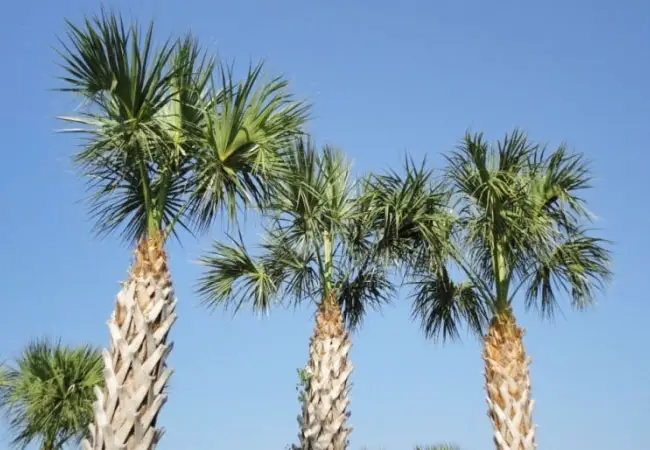
We all dream of having lush green palms without a hint of brown leaves. So, many gardeners start trimming their palms at the first sight of a brown tip. Over-pruning is a common issue.
Here’s the scoop: Palms are smart. They move nutrients from dying leaves to fuel new growth. Cutting off those leaves prematurely means losing those precious nutrients. Don’t snip those leaves until they’re completely dry. Plus, trimming certain palm fronds can halt new growth on that particular frond.
I stumbled upon some articles online suggesting that cutting brown tips can save palms from wasting nutrients on dying fronds. Big mistake! If your palm tree starts looking like it has a rooster tail, you’ve over-pruned it.
10. Hurricane Pruning
Some so-called professionals ((who probably don’t have enough work) might advise you to trim your palm before hurricane season to reduce the weight.
Please resist the urge. Your palm needs all the protection it can get from the wind. Whacking off too many green fronds will stress the palm out.
If you know a hurricane is headed your way, it’s better to tie the fronds together. Avoid pruning any fronds that hang above the horizontal plane of the crown.
11. Wrong Climate
An essential factor for a palm’s success is how much cold weather it’ll endure during winter. Always check the cold hardiness zone before getting a palm tree.
Not all palms can handle cold temperatures. If you live in a chilly climate, opt for one of those cold-hardy palms.
Another challenge can be humidity. Most palms adore high humidity, which can make them tricky to grow in dry conditions.
Before bringing home a palm, check its requirements and drought tolerance if you live in a dry climate.
12. Freeze Damage
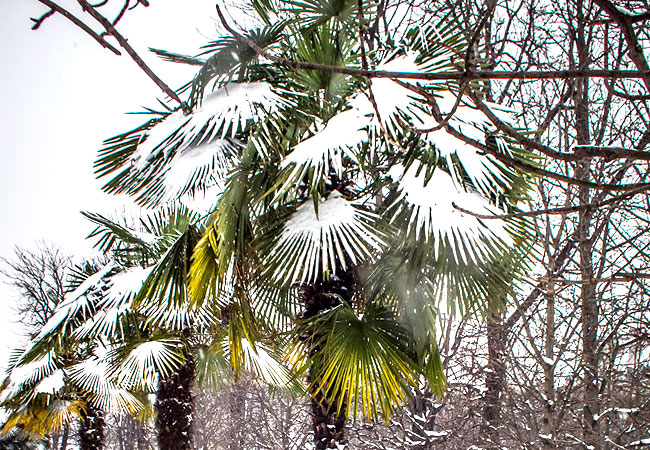
In recent years, even warm climates like Florida have experienced some brutally cold winters with temperatures plummeting below freezing. This chill has taken a toll on many palm trees.
Signs of cold damage can include wilting palms, crowns flopping over due to internal trunk rot, soft lesions on the outside of the trunk, and newly emerged leaves falling around the trunk.
When palm trees suffer from cold damage, they become susceptible to bacterial and fungal infections. To shield them from these pesky microorganisms, give them a good spray-down with Copper Fungicide. Sometimes, though, the damage is so severe that there’s little hope for rescue.
If you’re anticipating freezing temperatures, take precautions in advance. Check out my article on “10 Ways To Protect Palm Trees From Winter Freeze” for techniques to safeguard your palms. And remember, don’t fertilize a cold-damaged palm; it’ll only stress it out more.
13. Trunk Injury
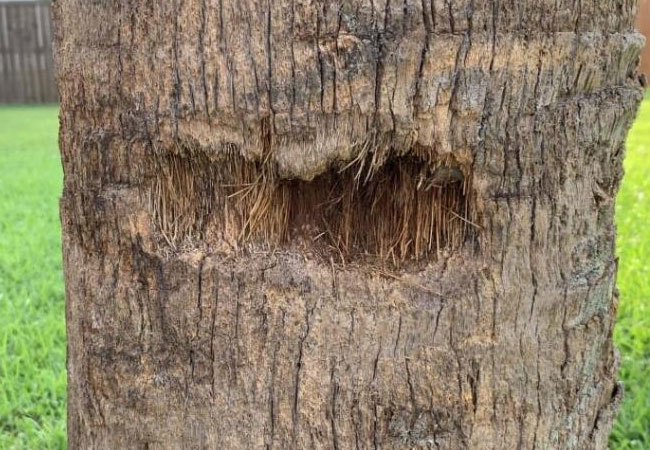
The palm tree’s bark can easily get damaged, leaving it vulnerable to insects and fungus. It’s not always easy to spot this damage right away, and diagnosis can be a bit tricky. Be extra cautious when transporting your palm.
Between the time you purchase the palm and when you plant it, ensure that the root ball stays moist but not soaking. Ideally, aim to plant your tree shortly after purchase.
If your palm comes in a plastic pot, don’t yank the palm tree out of it. Instead, make sure the soil is dry, and carefully cut the plastic pot away with a knife or scissors.
14. Lightning
Believe it or not, there have been cases where palms have been struck by lightning. When this happens, the leaves turn brown and start wilting. Skip the fertilizer, but do keep up with watering.
A palm damaged by lightning is at risk of bacterial and fungal infections. To guard against these threats, give it a good spray with Copper Fungicide.
However, if the palm’s bud was severely damaged by the lightning strike, it’s unlikely to survive.
15. Herbicide Toxicity
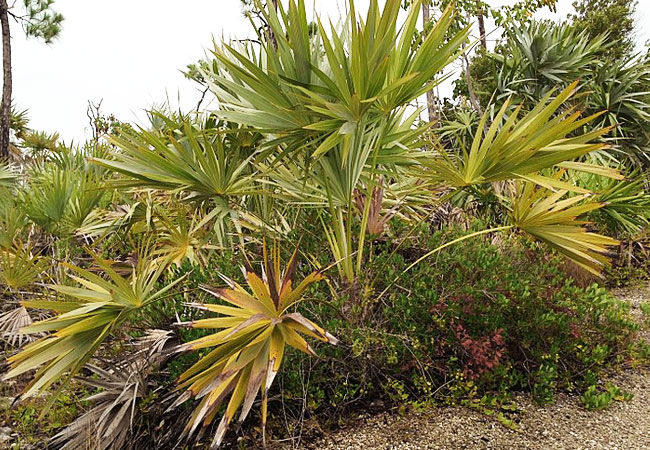
You might not give much thought to herbicide toxicity, but the damage it causes can take months to show. Some signs of herbicide injury closely resemble freeze damage, making it tricky to spot.
Look out for under-sized, deformed new growth with patches of dead tissue on the leaves. Take extra care when using various types of weed killers around your palms.
16. Leaf Spots
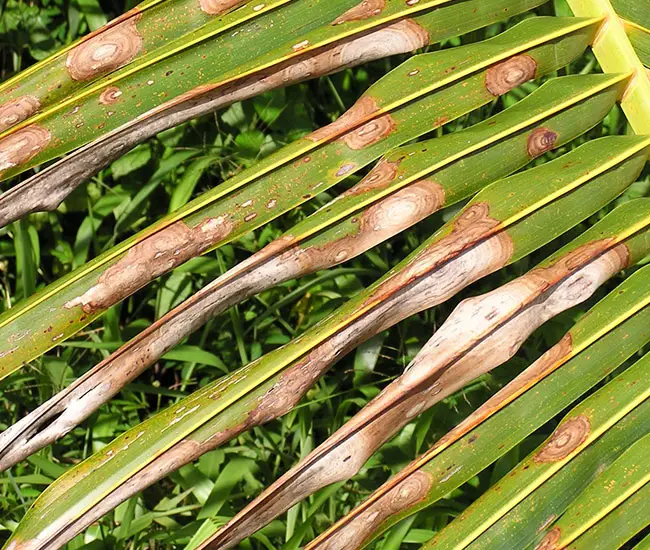
When a nutrient-deficient palm is stressed, it can fall prey to leaf-spotting fungi, which manifests as brown and yellow spots on the leaflets.
This condition often affects palms under stress from overwatering or poor drainage. Whether it’s a nutrient deficiency or drainage issue, address the underlying stress first.
Avoid getting water on the foliage while watering the palm. In most cases, the leaf spots will disappear without needing fungicide treatment.
In severe cases, you may need to spray the affected area with fungicidal sprays containing copper hydroxide or copper salts of fatty acids.
17. Lethal Yellowing
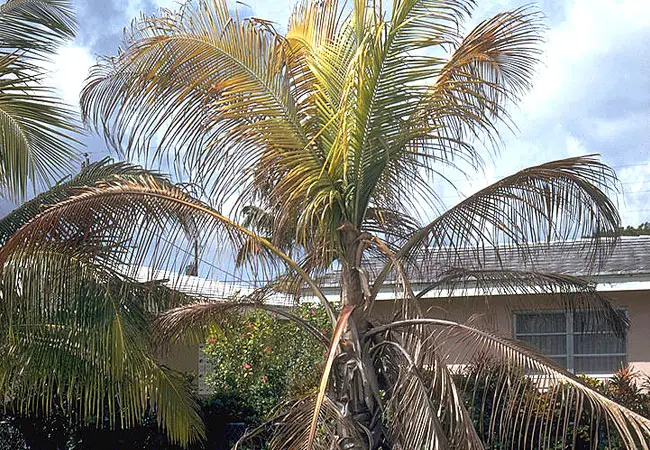
Lethal Yellowing is a deadly disease transmitted by an insect called Myndus crudus. Signs include blackening on the fruit stems, premature fruit dropping, and blackening of new flowers.
Old fronds may turn grey, yellow, or brown, eventually leading to the entire crown falling off. Unfortunately, there’s no cure for Lethal Yellowing disease.
The best course of action is to remove the infected palm to prevent its spread to other plants.
18. Bacterial Bud Rot
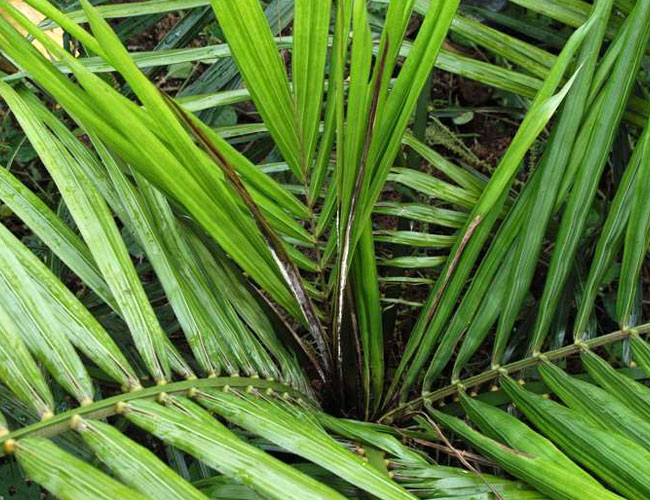
Cold-damaged palms can fall victim to bacterial bud rot disease. Keep an eye out for a discolored and wilting new leaf spear. The affected leaf spear may easily pull away from the bud, and a foul odor can also be an indicator of the problem.
As with many other diseases, drenching the affected area with copper-based fungicides can help eliminate it. That’s one of the reasons why I always recommend applying copper-based fungicides before the cold snap.
19. Fusarium Wilt
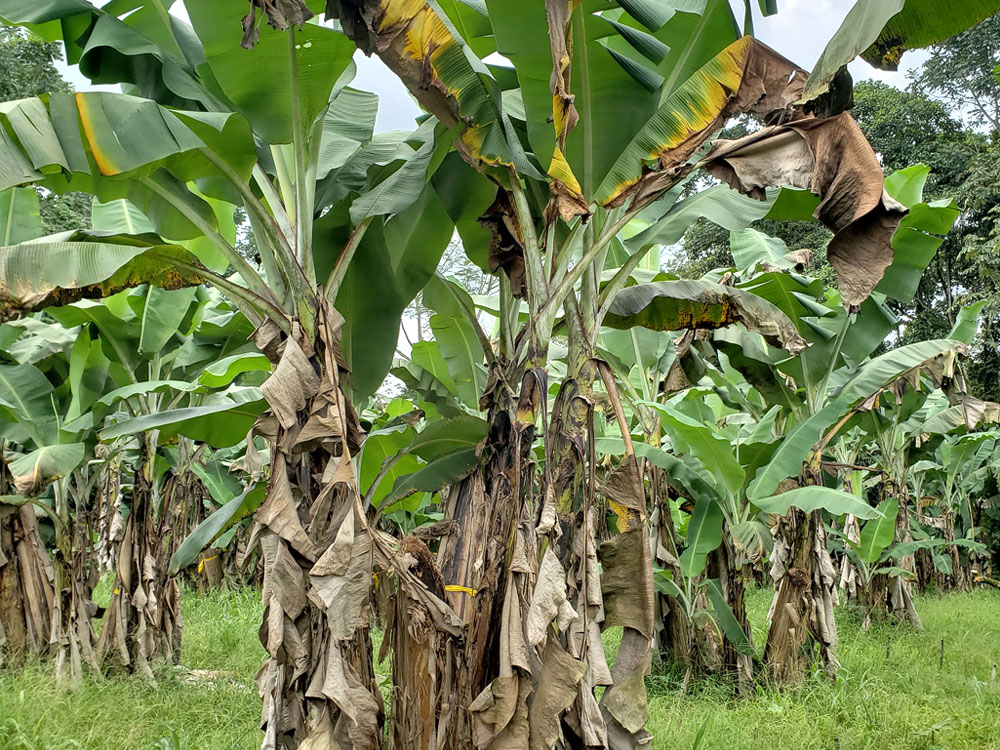
If your palm becomes infected with Fusarium wilt, you’ll notice a dark brown or reddish strip along the leaf stem. Additionally, the oldest leaves will start turning brown on one side of the leaf stem.
Once all the old leaves have turned brown, Fusarium wilt advances to the new emerging fronds. It can take anywhere from a few months to a few years for the palm to succumb to Fusarium wilt and die.
Unfortunately, there’s no remedy for this disease. The best preventive measure is to disinfect your tools to prevent its spread from tree to tree.
20. Ganoderma Butt Rot
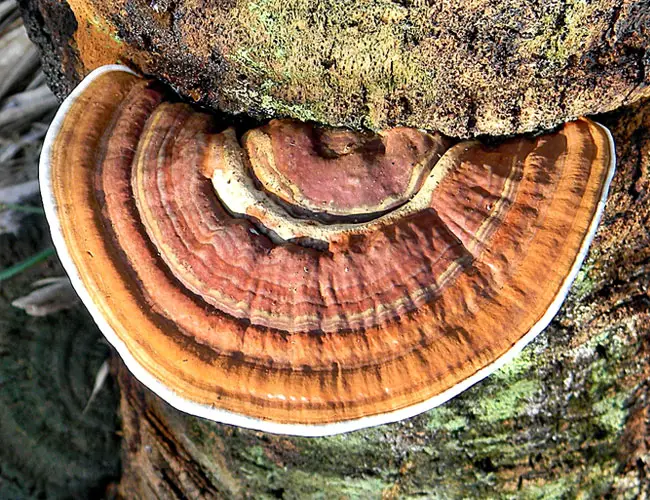
Ganoderma Butt Rot is a lethal disease caused by a fungus. It affects the lower portion of the palm’s trunk, hence its name Ganoderma Butt Rot. Detecting it can be tough because there aren’t many symptoms to watch for.
This disease silently eats away at the trunk tissue from the inside, forming a white spongy growth that turns brown as it matures. The fungal growth contains millions of spores that spread from tree to tree via the wind.
Sadly, there’s no cure for this disease. The only option is to remove the affected palm. First, cover that fungal conk with plastic to prevent spore spread. Then, dispose of the tree. Remember, Ganoderma can linger in the soil, so avoid planting anything in the same spot.
21. Bud Rot
Phytophthora bud rot is a common disease that strikes during hot, wet summers following tropical storms, heavy rain periods, or in palms severely damaged by freezing temperatures.
If your palm is suffering from bud rot, the new fronds will discolor and start wilting, and this can happen to the next set of new leaves as well.
Sometimes, you might spot black lesions on the new spears. Check if the new fronds come out easily. You might also notice a foul odor emanating from the bud.
In its early stages, if the damage isn’t too severe, you can try saving the palm by drenching the bud with fungicide. Whenever possible, avoid overhead irrigation.
22. Sooty Mold
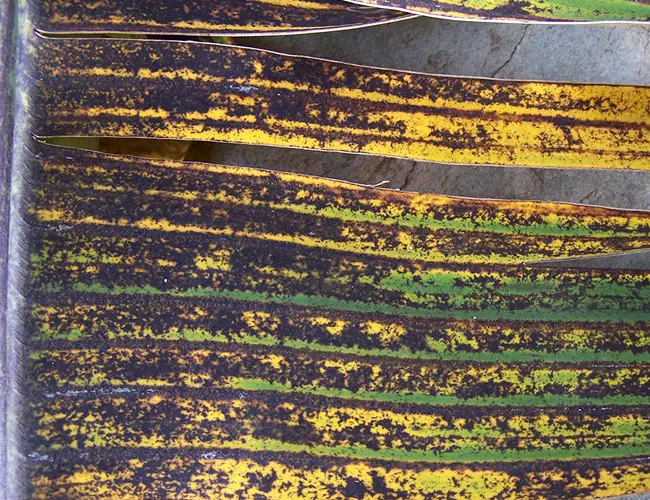
This superficial fungus doesn’t directly harm the plant but appears on the tree’s surface. It thrives on honeydew produced by palm aphids, mealybugs, or scale insects infestations.
Usually, it forms a black coating on the leaves that washes off easily. To prevent the development of Sooty Mold, manage honeydew-producing insects.
23. False Smut
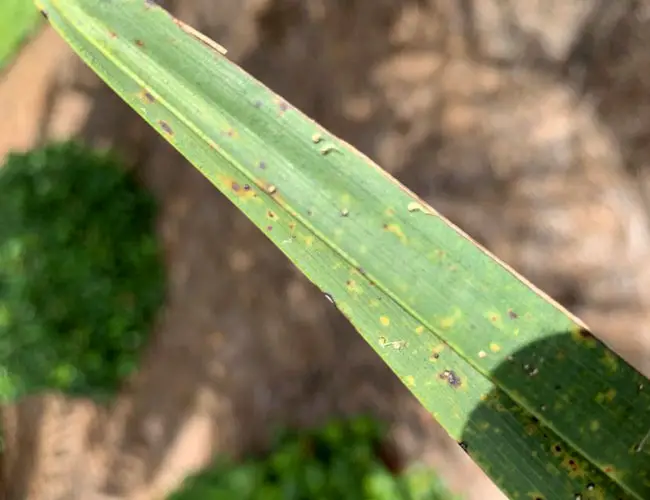
Another leaf fungus disease that affects palms under stress from overwatering or poor drainage is False Smut, also known as Graphiola leaf spot.
It initially manifests as yellow, brown, or black spots on both sides of the leaves. Older leaves are typically affected first. The fungus develops from these spots, producing yellow spores as it matures.
Primarily a cosmetic issue, it can be prevented by removing the affected leaves. You can also apply copper-based fungicides in the early stages to the remaining foliage to halt its spread.
Typically, it requires multiple applications throughout the year to eliminate it. The most commonly affected palms are Phoenix species, especially the Canary Island Date Palm and Date Palm.
24. Palm Leaf Skeletonizer
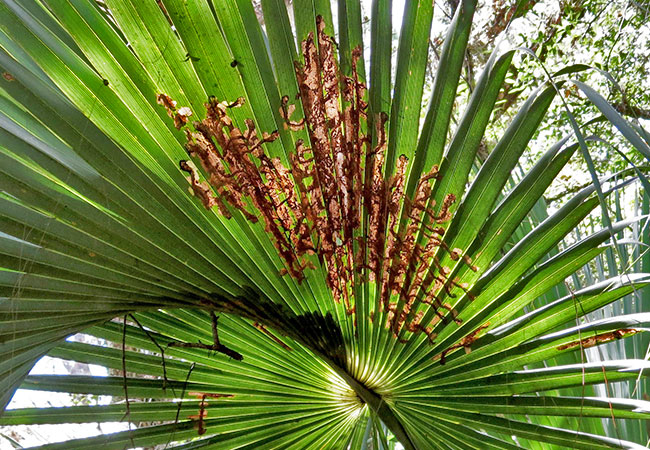
The palm leaf skeletonizer is the caterpillar of a small moth that feasts on both surfaces of palm leaves, leaving behind fibrous excrement known as “frass.”
They have a preference for munching on the tissue between the veins or ribs, creating a dark tube-like skeleton structure, hence their name, Leaf Skeletonizer.
These pests chew away at the palm leaves between the veins or ribs, giving rise to a dark tube-like structure that resembles a leaf skeleton.
Controlling this insect can be quite challenging. When spotted, remove the infected fronds and treat the rest with an insecticide containing carbaryl or a biological insecticide.
25. Palm Aphid
Palm aphids are stationary, dark brown bumps that feed on the newest growth of palm trees. They infest palms in large numbers, producing honeydew, which attracts ants. Ants consume the honeydew while protecting the aphids.
Infected palms display dark brown bumps with a white wax ring around them. Palm aphids can attack various palm species, but they are often found on Alexander Palms, Date Palms, Chinese Fan Palms, Coconut Palms, and Washington Palms.
To control palm aphids, insecticidal soap or horticultural oil can be effective, but you may need to reapply them multiple times.
26. Mealybugs
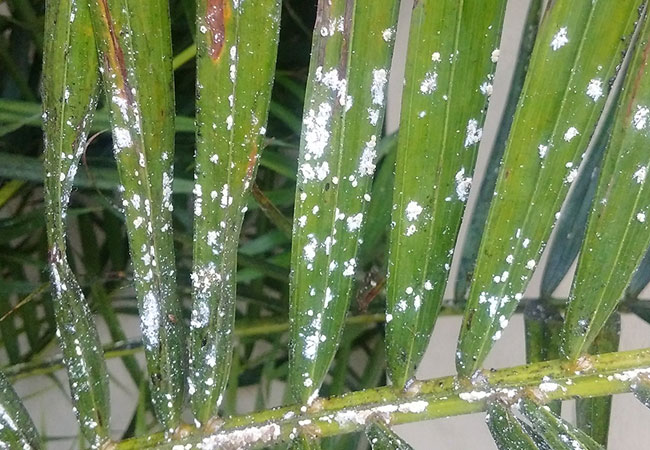
Numerous species of mealybugs can target palm trees. While some feed on the roots and are challenging to detect, most concentrate on the palm bud, where new fronds emerge.
Similar to palm aphids, they produce honeydew, which attracts sooty mold fungus and ants. On an infected palm, you’ll notice cottony white masses covering the new fronds and stems.
You can slow them down by applying a mixture of soapy water and alcohol. To completely eradicate mealybugs, spray the palm with insecticidal soap.
27. Palmetto Weevil
The Palmetto Weevil is a large beetle primarily attracted to severely stressed palms. However, a study from the University of Florida revealed that it could also attack entirely healthy palms. Some of its targets include Cabbage Palms, Canary Island Date Palms, Bismarck Palms, and Latan Palms.
This beetle, which can be black or sometimes red, lays its eggs in the leaf base of the palm. The eggs hatch, and the larvae start feeding on the plant, eventually making their way to the palm’s heart.
They destroy the bud and create cocoons from which adult weevils emerge. Diagnosing this problem early can be challenging, but if you do, treat the palm with insecticidal soap.
28. Saddleback Caterpillar
The Saddleback Caterpillar is a dark brown caterpillar with poisonous spines and a distinctive bright green pattern on its back that resembles a saddle. It creates large holes while feeding on the undersides of palm leaves.
You can manage young caterpillars with biological insecticides. Be sure to wear gloves to protect your hands from the spines.
It primarily targets palms like Christmas Palms, Butterfly Palms, Alexander Palms, Fishtail Palms, Coconut Palms, Princess Palms, Butterfly Palms, Mazari Palms, Canary Island Palms, Pygmy Date Palms, Queen Palms, and Mexican Fan Palms.
29. Scale Insects
Scale insects are a fairly common issue that can occasionally be found on palm leaves. There is a wide variety of scale insects, including Florida red scale, thread scale, Magnolia white scale, and soft brown scale. These small, legless, brown bumps target new growth, extracting fluids from it.
The most effective way to control them is by using horticultural oil, which needs to be reapplied multiple times to effectively eliminate them.
30. Spider Mites
Spider mites might sound like they belong to the spider family, but in reality, they’re tiny arachnids that belong to the Tetranychidae insect family, boasting an impressive 1,200 different species.
These tiny critters nibble on plant leaves and stems, sipping away at the sap. What’s tricky is how swiftly they multiply, setting up whole colonies in just weeks. They lay eggs beneath delicate silk webbing, and soon enough, you’ll have thousands of baby spider mites congregating on a single leaf.
Detecting these minuscule invaders can be quite the challenge due to their size. However, early detection is crucial because these pests are prolific reproducers and can swiftly spell doom for your plants.
If you spot spider mites on your palms, swift action is the name of the game to rescue your plants from their clutches.
One effective way to vanquish these invaders is by concocting a solution of regular dish soap and water, then giving your palm a good spray-down.
Related articles:
–Top 10 Palm Tree Care Mistakes and How To Avoid Them
–Top 10 Palm Tree Planting Mistakes You Don’t Want To Make
–5 Most Common Nutrient Deficiencies In Palms (with Pictures)
–Expert Tips: How And When To Fertilize Palm Trees
–5 Steps To Saving Freeze Damaged Palm Tree

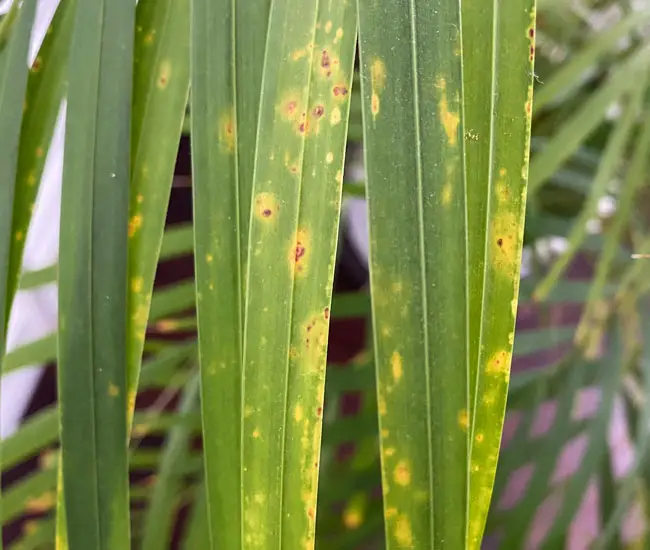
Just noticed one of my palms looks sick. Not sure what the problem is but its an established tree. Wish your article had images so I could compare mine.
Hi. My palm is about 25 feet tall and the core where new leaves come out is perfectly straight but ALL the green leaves are completely drooping down (like dead fronds). I live in Phx. Help?
I have a well-established ponytail palm that has five plumes on it and they have all suddenly gone limp. It is like the growth stopped being woody and firm and never hardened and eventually the fronds got too heavy and it has flopped over.
I tried to establish a splint on them to help but that doesn’t seem to be doing the trick. I’m afraid it is dying. It is a really nice specimen and I would hate to lose it.
It is planted inside my pool enclosure in full sun, sandy, well-drained soil and gets watered mostly by the rain and only on occasion by a hose if we have gone a really long time without. I’m located in central Florida.
Any ideas? Help!
I just bought a home in Orlando, Florida and found a palm tree in a pot of muddy potting soil. The bulb, which is about 3″ in diameter, is intact but there are very few roots. The crown is rotting. I removed the wet mushy stuff and found that there is healthy flesh deeper down.
How can I save this little guy?
I have already over watered and pruned my tree before I read how to save it. there is only half of one of the four limbs that looks alive there are no leaves. is it to late to save this tree?
I have already over watered and pruned my tree before I read how to save it. there is only half of one of the four limbs that looks alive there are no leaves. is it to late to save this tree?
Wood Peckers will not leave the tree alone. I didn’t know they were hollow until they started attacking. Is there something I can put one the tree to make them stop? What can I do about the damage?
I transplanted a palm that out grew a pot in a new home we bought. The palm start off strong but now has “stalled” – i.e. the fronds are stuck as in not coming all the way out as if it is clogged, There are only 3 left and the last one only came half way out. Not sure what to do. Thanks.
I have a palm tree that all the fronds are leaning to one side. I have cut back and still leaning? What should I do? Is there any way to post pictures? I know I am probably not describing the situation well.
My robeleniis are dying. there are a lot of dry leaves on them. One front is already dead. Its has no leaves and looks dead. this happened to another one of the palms. I don’t know what to do. can this palms be revived? I live in ca. where the weather is good. I water the plants twice a week and I put vitamin b on them.
I lost a beautiful Princess Palm Tree recently due to the ravages of the African Banana Slug. It’s a dull yellow color with a huge open lung for breathing on one side. About 10cms when fully grown with a crown that it can shrink it’s entire body under for protection. It exudes a slimy trail of such strength that if one walks over your hand, you have to literally scrape the slime trail off afterwards with a knife. I found one of them had bitten a 4cm round hole two meters up the the trunk of my King Palm. Inside the hole were about 20 baby Banana Slugs. It’s a terrible destroyer of large trees, eating into the roots & trunk. One suddenly find a previously healthy Palm reduced to one remaining frond, the rest hanging down dead. Even after much care & watering & fertilizing, the damn thing died anyway. The slug had eaten away the middle of the trunk. l believe this hideous monster is being studied in Paris beauty salons for the curative effects it has on wrinkles.
What causes on some particularly short cabbage palms the fronds to be cut off in a perfect arc? It is as if a deer ate the tips off but the missing tips are so perfect that I don’t think a deer would be that precise. Besides do deer ever eat palm fronds? Just curious.
Thanks
I’m not sure what’s wrong with my palm tree, how can I post pictures? The bottom leaves are yellowish in colour, with brown spots on them. The underneath of the palm leaf has some black speckles on it, looks like bugs but they do not move, also white powdery looking coating near the stem and leaves. I was assured at the nursery that there is nothing wrong with it, but I’m having doubts. I live in panama, I feel like I was sold a diseased plant. I wish I could post pictures so you could see it….thank you for your help,
Magda
We have a two Palms connected and the one is dying off how do we save it or if it dies can we cut it off to save the other side?
what’s solution for fungi on canary island palm trees dying pretty fast in S. California . Any spray of something?
My royal palm was infested with carpenter ants. I got rid of the ants and now the tree looks very stressed and is loosing all of its growth with no new growth. Is there anything I can do to save it? It’s a mature tree and I don’t want to lose it.
What is the white powder looking stuff on a couple of frongs and on the stem of frong? The tips of the frongs are brown and then yellow about three inches below the dry brown tips? Also, a couple of the stems are turning kinda yellow coming out of the trunk…? Tree planted June 2015 in Houston TX. Looked fine until winter months. We turned off sprinklers for two months but did get some rain during winter. Do I need to spray for mites? If so with what? The tree has some new growth coming out in center of tree.
Hello!!! I wanted to ask what was the factor that is most likely the reason palm trees have trouble growing? Awesome article!!!
My palm tree is about 3 yrs old and it seems to be dyiny.
The leaves are dark green and it’s still getting new leaves, but the leaves look like there wilting.
The base is real long and now it looks like it has a Mohawk .
Please help.
Thank you
Allison
Do you know how to force pups from Mediterranean Fan Palms? My gardener trimmed all the pups and they have not returned. I lost what I wanted – the shrub like effect with the pups.
I hope you can help.
I would like to know how can I save my bismarckia.. I HAVE PHOTOS… PLEASE HELP!
hello, I would like to get help to save my bismarckia please.. I have photos of the palm tree.. I dont know what can I do… thank!!
Great information very helpful lots to digest and it’s very tasty. This is going in the garden info book.
help my date palm looks like it is sick. all the leaves are turning brown and looks like they are drying out. it is all the bottom leaves but it seems as though it is beginning to make its way all the wa up to all the leaves. the trunk looks good no sign of anything there. I did not note e any spotting on the leaves they are just dry. Can I send a picture?? Please I don’t want my tree to die it is old and well established. what can I do?? can I send you a picture
the three x 9 was weird .
so here is my question. some very unconscious crazy nature hating people in my community thought it would be a good idea to cut down my beautiful 10 ft areca palms -turning them into stumps that are about a foot high. is there anything i can do to help them through their shock( the palms) and get them to grow again? I’m heartbroken and angry. thanks-
Yes, I am human. I believe I have a Carpentaria Palm and noted that the center shaft growth has turned brown. Please help. Thank you, Mary Kielbania
Great,many thanks for the advice. I live in far-away Zimbabwe and its winter-time here now. It gets quite cold at night (down to about 5 deg.Celcius – even a bit of ground frost occasionally. Our winters are totally dry, though it does sometimes get cloudy. I’m worried about my four-year-old Triangle Palm living in a large clay pot. There’s nothing obviously wrong; no brown patches, no dead leaves, no injuries. It has been flourishing up until this winter, but now the five fronds are looking limp and weak and the individual leaves are rolling up longitudinally. It is watered about once a week, but I try to be careful not to over-water it. I think the soil might be too heavy (it’s quite clayey, although it has been mixed with river sand). But I don’t think I should transplant it in the cold season, or plant it out in the garden until it warms up in late August/Sept. It may also have “outgrown” the pot, which is about 3-feet deep x 15 inches wide. Do you have any advice?
Kind regards,
Andrew
My palm is dying and I need help, I think I may have over pruned but im not sure. Some of the ends seemed brown so it trimmed them off in hopes that those leaves had just lived out their lifespan. Instead of the ends turning brown the brown, its running down the sides of the leaves. I have always kept it inside and I haven’t moved it from the pot that it was bought in because I am remodeling my house and I am afraid that it may get damaged outside with all the work going on. Ive had it for about two months now and it was doing really good until about a week and a half ago. This is my first palm tree so I need some help. Any suggestions?
Hello, I haven’t found one explanation of why my royal palm tree fronds are breaking. The leaves are green, the trunk looks healthy, but some fronds look weak from the bottom. It’s about 25 ft tall. I don’t know what to do!
Thank you.
Great information. Fairly readable and complete for a novice yard guy who just moved to Florida and has no idea how to take care of the different types of palm trees in my yard. Very helpful. Thanks.
Kindly advise me what i hv to do after planting a huge palm tree and after 10 days the leaves are drying. …..actually i planted two…but the other seems fine.
Tks
I transplanted a fishtail palm and all the leaves have turned brown. However there is new growth near the base of the tree.
Do you have any advice as to what to do with the top of the tree?
Thank you in advance.
My Windmill Palm is starting to get black, not brown on the the tips. What is wrong with it and what can I do to fix it?
My palm tree has a split in the trunk where the ball of the leaves begin. What caused this and how do I remediate.
My Pygmy palms have all died at the same time looked for source other than overwatering
I believe that’s the culprit so know I would like to know do you have a suggestion as to what I can replace them with
I loved the Pygmy and the way it looked what do you think
Thanks Angie
The top of my Palm tree came off due to removing old leaves I tried to save it buy putting cheesecloth to protect it and it fell off the trunk can it still be saved or replanted
My phoenix palm has spear rot. It is already 10 years old and was always healthy. Can anything be done to save it?
Coconuts trees planted over 50 yrs ago started to wither and then died ( all leaves including the stock bloom leaf withered) other younger trees 40 yrs old also died in quick succession. Both trees were 50 meters aoart. Location is karachi. Pakistsn.
We have a mature areca palm that has kost two out of six trunks now. The tips die out. Is our tree dying? Can we do anything to help it?
Hoping you can help us. From the pictures on the internet our potted palm trees resemble the cabbage palm as shown on one of the web sites. We live in south western Ontario where our trees are indoors from mid Oct. to mid May to avoid freezing. We bought them from a local nursery about 8 yrs ago, separated them to their own pot. At present they approx. 4 feet, 31/2 feet and 2 feet tall and two out of the three are about 41/2 inches in diameter; however the 3rd one which is 4 feet tall seems scrawny at about 3-31/2 inches in diameter and it appears to be dying since the top 6 inches or so feels soggy and all the leaves are discolored and drooping down which is unusual. If I was more computer savvy I would send a picture to accommodate the email. Could you please answer a few questions for me.
1) Is there any thing we can do for this tree that seems to be on it’s way out?
2) We’ve noticed some small bugs mainly after watering in the soil as well as on the leaves even after spending lots of time hand cleaning the tree with a mild detergent on different occasions.
3)What would be the ideal soil type or blend and how often should it be change for maximum benefit for the trees?
4) How often should we fertilize, what seasons to fertilize and how much, and do you recommend a certain type?
5) Your advice on watering both indoors and outdoors.
Thank you in advance for your help, our trees are a big part of our home.
Paul
Great article. I am noticing that my queen palms (and sego palms for that matter) are not getting any new growth. Existing fronds are getting sparse and starting to fall and nothing new is growing in its place. These palms have been planted for about 18 months. What do you think my problem is?
BTW… I live in Los Angeles area and water these twice a day for about 8 minutes, every other day. Thank you!
I have a recently planted a palm but I was naive so I used Lowe’s Tree & Shrub soil/fertilzer (although mixed in with existing dirt. I also used some Miracle-Gro liquid (with the hose) on it as well. Well it continues to grow to sprouts but is brown on the tips and becoming stringy. I would like to know how I can save it, it was expensive. HELP!!! Thanks so much
Oh, I also don’t know if the cavity for it provides the best drainage. We live in Texas and 2ft down it’s clay so I made a big hole for it and used a lot of fill dirt/fertilzer/soil. Thanks for your help
Our tall palm trees trunk has blackened, had many small holes, like from a Wood Pecker, and the upper holes are weeping sap. The palms look healthy. Unsure what to do. Thank-you in advance for your help.
The net like covering of trunk is falling off and a white area is at base of twenty-five year old Palm. What to do?
I need help identifying what’s going on with my palm tree. It’s slowly dying and I need help asap to save it. It’s an established palm tree in my backyard that seems to have white patches on the bottom stem of the leaves. I think these white patches are slowly killing my tree because the tree’s leaves are dying/withering away turning brown and dried more than usual. Please help me, I’ll provide pictures if needed.
Our palm trees have started dying from the bottom up. We’ve had these trees for 15 years. They’ve never done this before. We live in Alabama . Lower west side. We did not have a very cold winter. Only got down in 20’s twice. We have had many much colder winters. Please help me save these trees.
i had three palm plants in a pot.i kept them outside in the winters .the leaves turned brown and my gardener trimmed them leaving behind only the stem.i changes the soil and added fertilizer but it did not revive back.what shall i do now
My queen palm snapped in the center palms and is not sprouting any new palms can I do anything to promote further growth or is it a goner?? Please help!!
Two of the newest fronds of my sylvester palm (15 ft. high with 7 ft trunk) have simply fallen out of the tree in the past week and a half. The tree looks generally healthy, but I have never seen this happen with a sylvester before, and I am frightened for the tree. It is the center-piece of my landscaping, and I would do anything to save it. We have been having an unusual rain-shortage for this time of year in central Florida, but I have a good irrigation system and have been watering the tree faithfully but not excessively. I will be going away from home for a month starting June 12, so I am desperate to insure the health of the tree before I leave.